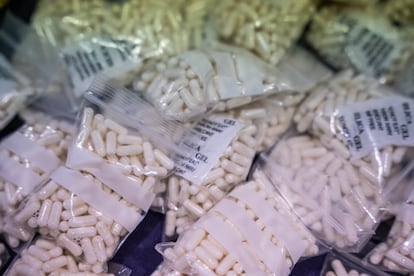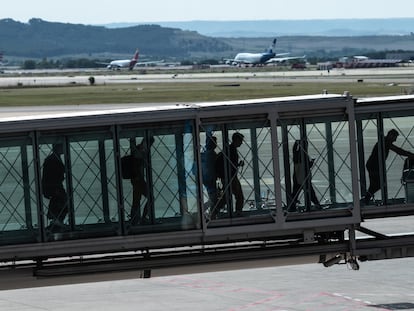Inside a drug lab: Trafficking rings import chemists to teach ‘cooks’ how to disguise cocaine
International cartels are increasingly using sophisticated systems run by specialists in hiding narcotics, who are capable of impregnating the drug into anything from canned oil to clothing
Jairo H. C. is 69 years old and has dedicated his life to cocaine. His subordinates referred to him as “El Señor” and he was the target of law enforcement agencies in several European countries. He was arrested in June, in his laboratory in a house in Villanueva de la Cañada, a municipality in the region of Madrid, Spain. El Señor is an experienced “cook” — a drug chef, as criminal organizations and security forces call them — one of the key figures in processing the products that reach the consumer. On a higher rung are the so-called chemists, who do not necessarily have formal education in the subject, but who know how to make the secret formula to impregnate and extract drugs from any object or substance. Without the chemists, there is no business. “They can camouflage [cocaine] in anything you can imagine. We have found it in clothes, in coffee, in cement, in fruit pulp...,” say investigators at the headquarters of the Central Brigade of Narcotics of the Spanish National Police Corps.
“More and more drug stashes are being detected with impregnated drugs,” says a police officer. The reasons are obvious: using this method, it is more difficult to track drugs via shipping records and easier to avoid them being stolen from the traffickers by common criminals. Impregnating drugs in literally anything imaginable is the preferred security method of drug-trafficking organizations, according to police sources. As such, the role of chemists and cooks is more important than ever. They are the ones who get their hands dirty. Using a chemical formula, they camouflage cocaine in the chosen object, and once it arrives at its destination, the reverse process is carried out to extract the base, which is then dried to obtain the white powder that reaches the illicit drugs market. Within the trafficking organizations, this is known as “the system.” Sometimes it is so sophisticated that it is practically indecipherable. Three years ago, Polish authorities intercepted drums of canned fish oils in which they knew drugs were being transported. But they have been unable to crack the formula to unmask “the system.”
“The person who designs the formula doesn’t necessarily have to have any theoretical knowledge — many lack basic education — but they have learned how to do it by watching others,” says an inspector from the narcotics brigade. “How many locks do you want?” is the first question a chemist asks, referring to the security level. The maximum is three, which means that the formula will be more complex and difficult to detect, but also that more drugs will be lost in the process. It is a question of priorities. “If you ask for level 3, we have to carry out very specific laboratory tests to detect them, but you leave half of the cocaine behind,” explains an agent specializing in narcotics. Chemists also charge depending on their notoriety and the amount of work they will have to undertake. “Sometimes they have so much power that they check out the place the organization has chosen to set up the laboratory first. If they are not convinced that is sufficiently off the grid, the operation is suspended until another one is found,” adds another investigator.

Real-life ‘Breaking Bad’
The police have even arrested professors or university graduates in the pay of criminal organizations. In June, the narcotics brigade launched Operation Butterfly, in which they dismantled a synthetic drug distribution network throughout Spain. They seized 150,000 ecstasy pills, 135 kilograms of amphetamine and four kilograms of pink cocaine. The laboratory where the drugs were processed was located in the Madrid satellite town of Alcalá de Henares and run by a 32-year-old Spaniard with a degree in pharmacy whom investigators nicknamed “Breaking Bad” after the popular television series in which a high-school chemistry teacher becomes embroiled in the business of manufacturing methamphetamine. The man’s mother, the owner of an esoteric store, helped him in the distribution of anabolics that he produced and supplied through the business.
This phenomenon has also been observed in other countries. In October 2020, Mexico was shocked to learn that a chemical engineer from the prestigious National Autonomous University, a certain Salvador C., was in charge of a laboratory dismantled by the authorities in an investigation code-named Operation Blue. In that case, the engineer’s job was to manufacture fentanyl, the substance that is causing a public health crisis in several U.S. cities.
Cooks or chefs usually occupy a lower link in the chain and are sometimes led to the drug labs blindfolded, so they have no idea where they are located. This process is international in scale: they are generally installed in a property on the outskirts of a big city or in an isolated village to process drugs for the duration of their tourist visa. Once in the laboratory, the chemist explains the process to extract the drug to the cooks, as if they were his assistants. “For them, coming to work in Europe is like playing in the Champions League, that’s what the Mexican authorities have told us,” says a narcotics brigade agent. The chemists are kept in close confines. Police analysis of seized cellphones have verified that some have been reprimanded for sending photos to their relatives or friends from inside the laboratory. They are not allowed out even to eat: a quartermaster is provided who cooks or brings them food.
There are also cases in which a chemist turns out not to possess the expertise claimed when hired by the drug traffickers. This, inevitably, leads to problems in the country where the drug is processed. “During surveillance, we detected that there was some issue, that the process was stopped. We didn’t understand what was going on. When we arrested them, we discovered that they had run out of ammonia and went to a supermarket to buy more. But they bought a perfumed one, with a different composition from the normal one, so the system wasn’t working,” says an inspector from the brigade.
The chemists also keep their eyes on current events and choose specific shipments in which to impregnate cocaine. “If they read that there is a shortage of some raw material due to the war in Ukraine for example, they send a shipment from the other side of the Atlantic containing that particular product because it will attract less attention being imported at that moment,” says a researcher. There is no stone left unturned to find the perfect formula.
Sign up for our weekly newsletter to get more English-language news coverage from EL PAÍS USA Edition
Tu suscripción se está usando en otro dispositivo
¿Quieres añadir otro usuario a tu suscripción?
Si continúas leyendo en este dispositivo, no se podrá leer en el otro.
FlechaTu suscripción se está usando en otro dispositivo y solo puedes acceder a EL PAÍS desde un dispositivo a la vez.
Si quieres compartir tu cuenta, cambia tu suscripción a la modalidad Premium, así podrás añadir otro usuario. Cada uno accederá con su propia cuenta de email, lo que os permitirá personalizar vuestra experiencia en EL PAÍS.
¿Tienes una suscripción de empresa? Accede aquí para contratar más cuentas.
En el caso de no saber quién está usando tu cuenta, te recomendamos cambiar tu contraseña aquí.
Si decides continuar compartiendo tu cuenta, este mensaje se mostrará en tu dispositivo y en el de la otra persona que está usando tu cuenta de forma indefinida, afectando a tu experiencia de lectura. Puedes consultar aquí los términos y condiciones de la suscripción digital.
More information
Últimas noticias
There is as much life left to discover on planet Earth as that which is already known
Dozens presumed dead, around 100 injured in fire at Swiss Alps bar during New Year’s celebration
Is porn for women different from conventional porn? We spoke to those who make it
Cartagena de Indias is sinking: What can the city do to mitigate it?
Most viewed
- David King, chemist: ‘There are scientists studying how to cool the planet; nobody should stop these experiments from happening’
- Reinhard Genzel, Nobel laureate in physics: ‘One-minute videos will never give you the truth’
- Oona Chaplin: ‘I told James Cameron that I was living in a treehouse and starting a permaculture project with a friend’
- Sinaloa Cartel war is taking its toll on Los Chapitos
- The Interoceanic Train, the Mexican alternative to the Panama Canal











































